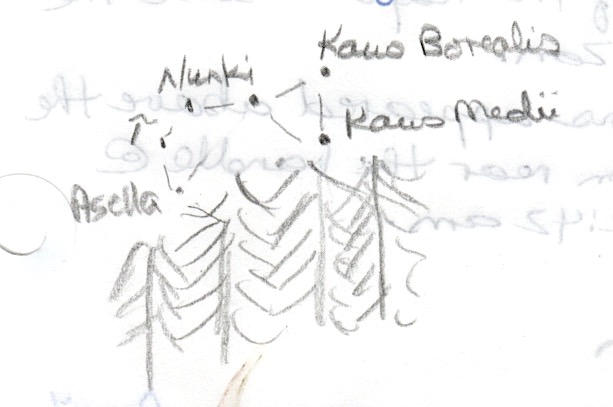
Constellations: Capricornus, Cassiopeia, Delphinus, Lyra, Ursa Major
Asterism: Coathanger/Collinder 399/Brocchi's Cluster, Keystone of Hercules, Square of Pegasus, Teapot
Satellite: (1)
Messier Objects: M8, M13, M20, M21, M31
Location: Crawford Notch Campground on the Saco, White Mountain National Forest, New Hampshire
Date: 2017-08-25
Time: 9:00 PM - 10:30 PM EDT
Instrument: Visual + Binoculars 10x30 IS
Transparency: Fair (2) - Poor (1)
Seeing: Fair (2) - Poor (1)
Temperature: 16º C - 14º C
No wind and light clouds occasionally. High humidity and light pollution to the E-SE. We did our viewing from the rocky beach of the shallow, cold water river. There was a steep cliff directly across from us that cut off our view to the East.
|
Teapot (in Sagittarius) |
 |
Delphinus Time: not recorded S&T Chart Reference: 64 The 5 stars of Delphinus could be easily seen but they were not as bright the evening before. Showed it to Steve (a photographer on the beach). |
|
Lyra |
|
|
Keystone of Hercules (in Hercules) Satellite |
Cassiopeia Time: 9:48 PM EDT S&T Chart Reference: 1, 3, 72 Instrument: Visual + Binoculars Could identify all 5 stars of the constellation due to their magnitude. Surrounding stars not easily seen naked eye but could be seen with binoculars. |
|
Ursa Major |
Capricornus Time: 9:55 PM EDT S&T Chart Reference: 66, 68, 77 Instrument: Visual + Binoculars Saw 2 stars in vertical alignment and used my binoculars to confirm it was Capricornus α and β. Could not easily see the other stars in this constellation due to the light pollution. |
Square of Pegasus (in Pegasus)
Time: 10:00 PM EDT
S&T Chart Reference: 74, 75
Instrument: Visual
Just before leaving the beach, 3 of the 4 stars in the Square (Scheat, Algenib and Alpheratz) were visible above the cliffs across the river from us.
Coathanger /Collinder 399 / Brocchi's Cluster
Time: 10:25 PM EDT
S&T Chart Reference: 65
Instrument: Visual + Binoculars
Could not locate Albireo earlier in this session so decided to use Altair as the start point. Success! All 10 stars easily found with the binoculars. Showed this to Steve as well.
Messier Objects
| M8 (Lagoon Nebula) Time: not recorded S&T Chart Reference: 67, 69, I Instrument: Visual + Binoculars The hazy skies and the tree line it made for difficult to find the spout of the Teapot; however, knowing where the lid was located, I was able to find the nebula. The line of stars plus the grey fuzzy area around and mostly above the line were easily seen in the binoculars. |
M13 (Hercules Cluster)
|
M31 (open cluster)
|
|
M20 (Trifid Nebula) |
M21 (open cluster)
|